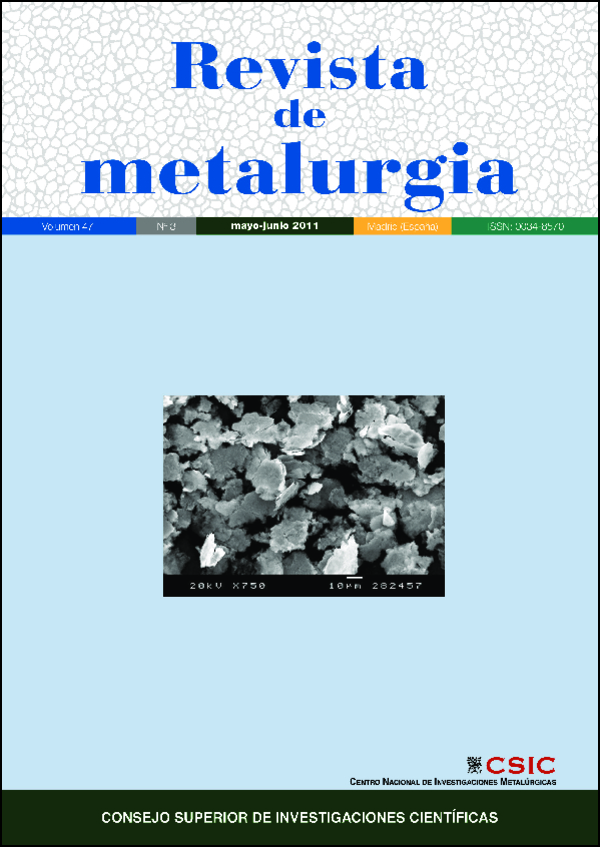Coagulation of fines in fluorite froth flotation
DOI:
https://doi.org/10.3989/revmetalm.1037Keywords:
Flotation, Fluorite, Reagents, Slimes, CoagulationAbstract
Fluorite, a valuable mineral in the metallurgical industry, can be found together with silicates, carbonates and oxides in ore deposits. Commercial concentrates with more than 95 % of CaF2 are obtained processing the mineral in flotation plants and using oleic acid as fluorite collector. Depressor reagents such as sodium silicate, tannin and sodium carbonate are commonly employed to allow the oleic acid selective performance. These reagents cause a dispersant effect separating the solid-liquid solution on tailing plants. Fine particles in the recovered water enter the circuit and affect the flotation efficiency. The effect of coagulant ions was studied as a method to clarify the returned water. The problem of the presence of these ions is related to its reactions with the collector by the formation of compounds and possibly on the selectivity. Variable quantities of Al3+, Fe3+ and Ca2+ ions were added to the flotation to evaluate its effect on the fluorite recovery, in the selectivity and in solids content in recirculation water. Results show that some ions fail to improve water quality and are detrimental to flotation. On the contrary, some ions contribute to reduce fine content in suspension. Therefore, although there is a recovery reduction, such effect can be counteracted increasing the collector consumption a little.
Downloads
References
[1] D.R. Nagaraj, Minerals recovery and processing, Ed. Kirk Othmer, Separation Technology, 2nd Edition, EE.UU., 2008, pp. 659-732.
[2] A. Peck, U.S. Bureau of Mines, RI 6202, 1964, pp. 14-16.
[3] K. Marinakis y H. Shergold, Int. J. Miner. Process. 14 (1985) 161-176. http://dx.doi.org/10.1016/0301-7516(85)90001-8
[4] W. Thomas, Mining Chemical Handbook, Ed. Cyted, EE.UU., 2002, pp. 69-130.
[5] R.K. Hanumantha y K. Forssberg, Miner. Eng. 4 (1991) 879-890. http://dx.doi.org/10.1016/0892-6875(91)90071-3
[6] S. K. Mishra, Int. J. Miner. Process. 9 (1982) 59-73. http://dx.doi.org/10.1016/0301-7516(82)90006-0
[7] W. Sampaio y C. Ferreira, VII Meeting of the Southern Hemisphere on mineral Technology, Ouro Preto, Minas Gerais, Brazil, 2007, pp. 243-251.
[8] H. Schubert, H. Baldauf y W. Kramer, Int. J. Miner. Process. 30 (1990) 185-193. http://dx.doi.org/10.1016/0301-7516(90)90014-P
[9] Y. Zhang y S. Song, Miner. Eng. 16 (2003) 597-600. http://dx.doi.org/10.1016/S0892-6875(03)00136-5
[10] P. Sarquís, V. Bazán, Universidad Nacional de San Juan, Informe IIM-023-08. Ed. FUNSJ, UNSJ, Argentina, 2008, pp. 8-11.
[11] J.D. Millar y J.B and Hiskey, Colloid Interface Sci. 41 (1972) 567-573. http://dx.doi.org/10.1016/0021-9797(72)90378-5
[12] M.C. Fuerstenau, G. Gutiérrez y D. Elgillani, Trans. AIME, 242 (1968) 319-320.
[13] G.V. Caesar, Starch and its derivates, Edit. J.A. Radley. Chapman and Hall, London, Inglaterra, 1968, pp. 221-223.
[14] J. Wang y P. Samasundaran, Miner. Eng, 18(2005) 77-81. http://dx.doi.org/10.1016/j.mineng.2004.05.013
[15] M.J. Pearse, Miner. Eng. 18 (2005) 139-149. http://dx.doi.org/10.1016/j.mineng.2004.09.015
[16] S.H. Chiang, Fluid Part. Separ. J. 6 (1993) 64.
[17] P. Somasundaran, Fine Particle Processing, AIME, Vol. 2, New York, EE.UU., 1980, pp. 947
[18] S. Chandler y H. Sis, Miner. Eng. 16 (2003) 577-585. http://dx.doi.org/10.1016/S0892-6875(03)00131-6
[19] H. Yuehua y R. Chi, Ind. Eng. Chem. Res. 42 (2003) 1641-1647. http://dx.doi.org/10.1021/ie020729b
[20] S.V. Dudenhov, Tsvet. Metallurgy 40 (1967) 18-21.
[21] V. A. Mokrousov, Gorny Zhurna 1 (1945) 30-33.
Downloads
Published
How to Cite
Issue
Section
License
Copyright (c) 2011 Consejo Superior de Investigaciones Científicas (CSIC)

This work is licensed under a Creative Commons Attribution 4.0 International License.
© CSIC. Manuscripts published in both the printed and online versions of this Journal are the property of Consejo Superior de Investigaciones Científicas, and quoting this source is a requirement for any partial or full reproduction.
All contents of this electronic edition, except where otherwise noted, are distributed under a “Creative Commons Attribution 4.0 International” (CC BY 4.0) License. You may read the basic information and the legal text of the license. The indication of the CC BY 4.0 License must be expressly stated in this way when necessary.
Self-archiving in repositories, personal webpages or similar, of any version other than the published by the Editor, is not allowed.
















